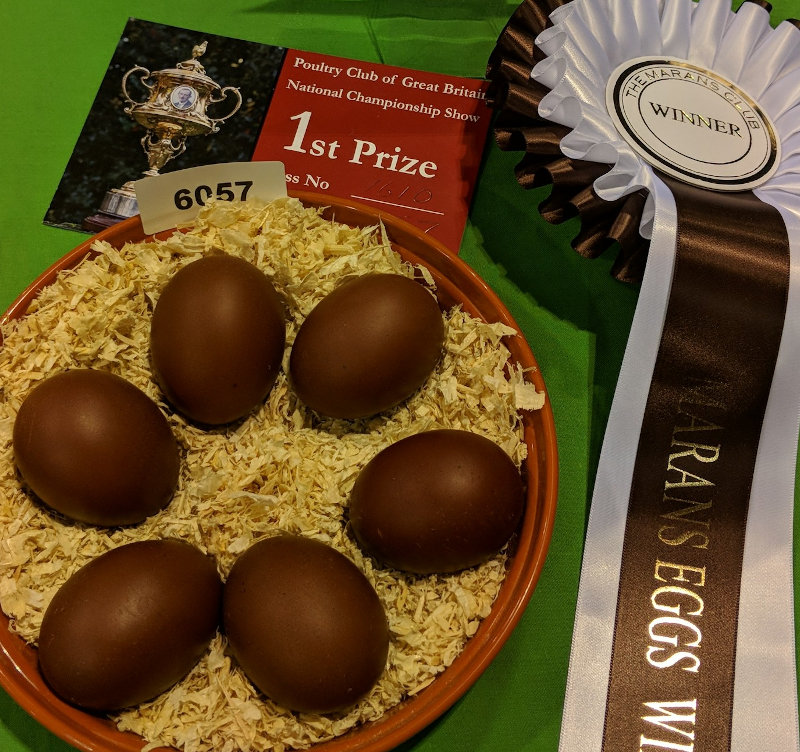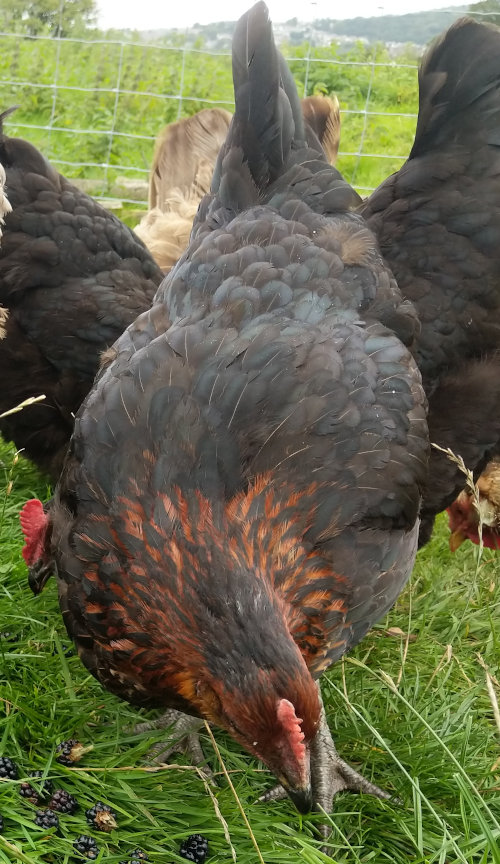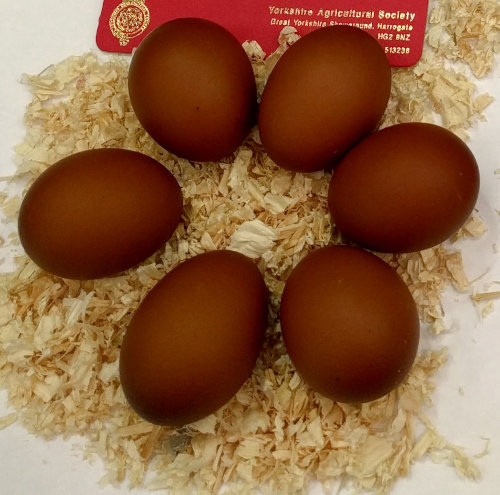The Marans breed standard.

The egg and colour standards are the same for both the bantam and large fowl Marans unless where specifically noted below.
The Marans breed standard serves the ideal. Conservation breeding of the Marans chicken has the goal:
- To preserve the original features and its origins.
- Keep the chicken healthy, free from injury, suffering or pain.
- Support its features, the main feature is the large, distinctive, dark reddish brown egg.
- Maintenance of the genetic blueprint.
My breeding goal for my flock of Marans chickens was slightly different and is mainly based on the colour of the eggs as I neither show them nor sell them as pure breeds.
Below: One of my 30 or so Copper Black Marans. Mine are kept purely for the dark eggs and not necessarily the proper breed standard.

Faults and general disqualifications in Marans chickens:
The following are severe faults in Marans:
- Yellow on shanks or toes.
- White ear lobes.
- Any feathers or stubs appearing on legs or toes of clean legged types.
- Feathers on middle or inner toes of feather legged types.
- Solid greenish black feathers, or red or yellow coloured feathers. Brassiness in hackle and saddle feathers is a serious defect.
- Body too weak, narrow or short, posture too upright, stance too high or low, ear-wraps, unopened runners, well-developed pillows and cuffs.
- Any colour in the feathers of the white variety.
- Rooster weighing less than 3 kg or hen weighing less than 2.2 kg.
- Light-coloured or black eyes
Please note that the English selection of Marans without feathered legs is not recognised in Europe and standards differ across the world depending on your country.
Marans chicken standard weights:
The following is a list of the minimum and maximum allowed weights for the different ages and types of Marans:
Rooster: 3,5kg (7.7lb) to 4,0kg (8.8lb)
Hen: 2,6kg (5.7lb) to 3,2kg (7lb)
Cockerel: 3,0kg (6.6lb) to 3,5kg (7.7lb)
Pullet: 2,2kg (4.8lb) to 2,6kg (5.7lb)
Bantam rooster: 1.1kg (2.4lb)
Bantam hen: 0.9kg (2lb)
Marans egg standard:
There are two distinct qualities for the Marans egg, firstly the eggs should be large, ranging in size from about 65 grams for a pullet to 70-80 grams for an adult hen and secondly they should have a deep, chocolate, dark red-brown coloured shell.
Below: A selection of Marans eggs from my copper blacks.

The eggs standards for the Bantam Marans calls for the same dark-brown shell and an egg weight of 40 grams.
The criteria to be evaluated are:
- The colour according to the scale, which should be uniform over the entire surface.
- The size. The egg should weight at least 65g.
- The form must be oval and not very pointed or round and have a shiny shell.
- The inside of the eggs is also evaluated for the golden yolk, the presence of blood stains, the consistency of the egg white.
For more on the Marans egg and how to breed for the deep chocolate brown.
Marans breed standards:
Standards for the Marans rooster:
- Hull(Body): Fairly long, wide, deep, well rounded with a slightly backward declining posture.
- Neck: Wide set and long, curved in towards the skull. Long and abundant hackle feathers covering the shoulders well.
- Back: Long, flat, slightly sloping backwards, without pads.
- Shoulders: Broad, rounded, set high.
- Wings: Quite short, close to the body.
- Saddle: Wide, full, rounded in transition.
- Tail: Wide set on, relatively short, full with short scapulae, carried moderately high, 45 ° to the horizontal.
- Breasts: Broad, full, well rounded.
- Abdomen: Broad, full, well developed.
- Head: Medium size, rather firmer, slightly flat on the side.
- Face: Red, smooth or with fine feathers.
- Comb: Single, moderately large, straight, upright, evenly serrated with five points.
- Lobes: Medium size, well rounded.
- Ears: Not too big, red.
- Eyes: Vivid, orange to red. Large and prominent.
- Beak: Fairly strong, slightly curved, horned.
- Thighs: Strong, only slightly protruding from the plumage, without pads and cuffs.
- Legs: Legs set well apart, straight when viewed from the front. Shanks-moderately long and smooth.
- Toes: Well pointed, outer finger slightly feathered.
- Feathering: Tight fitting.
Standards for the Marans hen:
Back almost horizontal. The tail is not too long, set wide and tapering towards the end. Abdomen well developed. Comb straight or inclined to the side, not exceeding the line of the eye.
- Comb: Single, moderately large, straight and upright, evenly serrated with five points.
- Beak: Long, stout and well curved.
- Wattles: Medium in size, oval.
- Earlobes: Medium in size.
- Head: Moderately large in size, slightly flattened on top.
- Neck: Of medium length, broad and well balanced, moderately close feathered.
- Tail: Full, rather short moderately spread, carried at an angle of 45 degrees above horizontal.
- Wings: Short, held close to body, carriage nearly horizontal.
- Breast: Strong, broad and full.
- Back: Long, flat, slightly tilted to the rear. Slightly less inclined than in the male.
- Body: Body deep, long and broad, especially through the shoulders and carried high. Overall, rectangular in shape. Fluff-medium length.
- Legs and toes: Similar to those of male.
- Plumage: Fairly tight and smooth textured.
The white Marans: All plumage should be pure white although some straw colour is tolerated in the hackles of the cockerel. Any other colouring in the feathers is a serious defect.
The black Marans: The feathers must all be completely black and the green sheen is not required. Any buff or white feathering is a serious defect.
The brown-red Marans, also called Black Copper-neck, Copper Black & Red Birchen: The hen is black with red hackle markings and no breast lacing although some chest colour is allowed. Green sheen is not a requirement. The cockerel is black breasted red with a black wing triangle, copper colour in the neck hackles and along the back with deep red shoulders. No brassiness, yellow or mahogany is allowed in the feathers.
The Silver birchen Marans: Similar in all respect to the copper black Marans but silver instead of copper colouring. Must be white with no colour or brassiness in the feathering.
The Silver cuckoo Marans: The hen has dark cuckoo plumage, with a rough pattern and irregular lines, lighter hackles and grey undercolour.
The Golden cuckoo Marans: The same as for the Silver Cuckoo except all silver or white areas are red or gold.
The columbian or ermine Marans: A white bird with black laced hackles, black tail and flight feathers. Under colour is white.
The wheaten Marans: In the male golden to brown-red head, lancets and hackles with red wing covers and a black wing bar . The black primaries are edged with brown and the secondary feathers have internal black edged and external brown edges, which forms a brown wing bay. The upper breast is black and its lowest parts blackish.
In the hen, the head and hackles are golden-red to brown and some black spots are allowed. Back, rump and wing covers are wheaten coloured. The tail feathers and the flights are black, edged with brown. The breast and the abdomen are cream and the under colour is whitish.
